Reduction of intraarticular adhesion of knee by local application of rapamycin in rabbits via inhibition of fibroblast proliferation and collagen synthesis
- PMID: 27094512
- PMCID: PMC4837638
- DOI: 10.1186/s13018-016-0375-0
Reduction of intraarticular adhesion of knee by local application of rapamycin in rabbits via inhibition of fibroblast proliferation and collagen synthesis
Abstract
Background: The formation of intraarticular adhesion is a common complication after total knee arthroplasty or anterior cruciate ligament reconstruction. Previously, little research was reported regarding whether the local application of rapamycin (RAPA) could reduce intraarticular adhesion following knee surgery. In our present study, we determined the therapeutic effect of RAPA by local application on the reduction of intraarticular adhesion following knee surgery in rabbits.
Methods: In this study, we built the model of knee surgery according to a previous study. The decorticated areas of the cortical bone were exposed and covered with cotton pads soaked with different concentrations of RAPA or physiological saline for 10 min. All of the rabbits were euthanized 4 weeks after the surgery. Macroscopic evaluation of the hydroxyproline content, the histological morphological analysis and collagen density and fibroblast density were used to evaluate the effect of RAPA on reducing intraarticular adhesion.
Results: The results shown that RAPA could significantly inhibit the proliferation of fibroblasts and reduce collagen synthesis; in the rabbit model of knee surgery, there were weak scar tissues around the decorticated areas in the 0.2 mg/ml RAPA group; moderate scar tissues were found in the 0.1 mg/ml RAPA group. However, severe fibrous adhesions were found in the 0.05 mg/ml RAPA group and the control group. The hydroxyproline content and the fibroblast density in the 0.2 mg/ml and 0.1 mg/ml RAPA groups were significantly less than those of the control group.
Conclusions: We concluded that the local application of RAPA could reduce intraarticular adhesion after knee surgery in the rabbit model; this effect was mediated by inhibition of fibroblast proliferation and collagen synthesis, which may provide a new method for reducing intraarticular adhesion after clinical knee surgery.
Keywords: Collagen synthesis; Fibroblast; Intraarticular adhesion; Rapamycin.
Figures
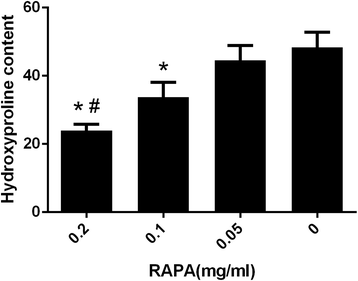
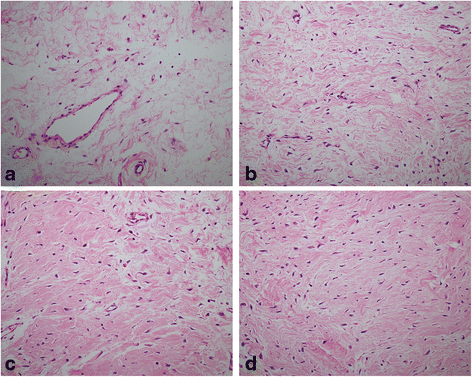
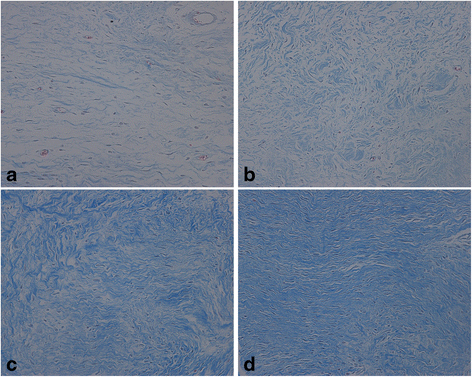
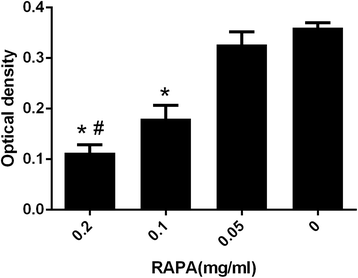
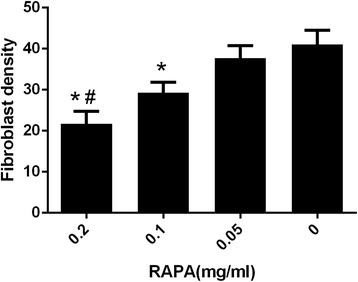
Similar articles
-
The effect of mitomycin C in reducing intraarticular adhesion after knee surgery in rabbits.Eur J Pharmacol. 2010 Sep 15;643(1):1-5. doi: 10.1016/j.ejphar.2010.06.005. Epub 2010 Jun 19. Eur J Pharmacol. 2010. PMID: 20599934
-
A comparative study of the preventive effects of mitomycin C and chitosan on intraarticular adhesion after knee surgery in rabbits.Cell Biochem Biophys. 2012 Jan;62(1):101-5. doi: 10.1007/s12013-011-9266-5. Cell Biochem Biophys. 2012. PMID: 22170604
-
Reduction of intraarticular adhesion by topical application of colchicine following knee surgery in rabbits.Sci Rep. 2014 Sep 23;4:6405. doi: 10.1038/srep06405. Sci Rep. 2014. PMID: 25245566 Free PMC article.
-
Comparison of the effects of mitomycin C and 10-hydroxycamptothecin on an experimental intraarticular adhesion model in rabbits.Eur J Pharmacol. 2013 Mar 5;703(1-3):42-5. doi: 10.1016/j.ejphar.2013.02.001. Epub 2013 Feb 17. Eur J Pharmacol. 2013. PMID: 23422876
-
Local application of rapamycin reduces epidural fibrosis after laminectomy via inhibiting fibroblast proliferation and prompting apoptosis.J Orthop Surg Res. 2016 May 6;11(1):58. doi: 10.1186/s13018-016-0391-0. J Orthop Surg Res. 2016. PMID: 27154399 Free PMC article.
Cited by
-
Types and doses of anti-adhesive agents injected into subacromial space do not have an effect on the clinical and anatomical outcomes after arthroscopic rotator cuff repair.Knee Surg Sports Traumatol Arthrosc. 2023 Nov;31(11):5238-5247. doi: 10.1007/s00167-023-07519-4. Epub 2023 Aug 18. Knee Surg Sports Traumatol Arthrosc. 2023. PMID: 37594502
-
E8002 Reduces Adhesion Formation and Improves Joint Mobility in a Rat Model of Knee Arthrofibrosis.Int J Mol Sci. 2022 Jan 22;23(3):1239. doi: 10.3390/ijms23031239. Int J Mol Sci. 2022. PMID: 35163163 Free PMC article.
-
Extensive adhesion formation in a total knee replacement in the setting of a gastrointestinal stromal tumor: A case report.World J Orthop. 2022 May 18;13(5):538-543. doi: 10.5312/wjo.v13.i5.538. eCollection 2022 May 18. World J Orthop. 2022. PMID: 35633745 Free PMC article.
-
Prospective application of stem cells to prevent post-operative skeletal fibrosis.J Orthop Res. 2019 Jun;37(6):1236-1245. doi: 10.1002/jor.24266. Epub 2019 Mar 21. J Orthop Res. 2019. PMID: 30835890 Free PMC article. Review.
-
Homoharringtonine inhibits fibroblasts proliferation, extracellular matrix production and reduces surgery-induced knee arthrofibrosis via PI3K/AKT/mTOR pathway-mediated apoptosis.J Orthop Surg Res. 2021 Jan 6;16(1):9. doi: 10.1186/s13018-020-02150-2. J Orthop Surg Res. 2021. PMID: 33407698 Free PMC article.
References
Publication types
MeSH terms
Substances
LinkOut - more resources
Full Text Sources
Other Literature Sources

